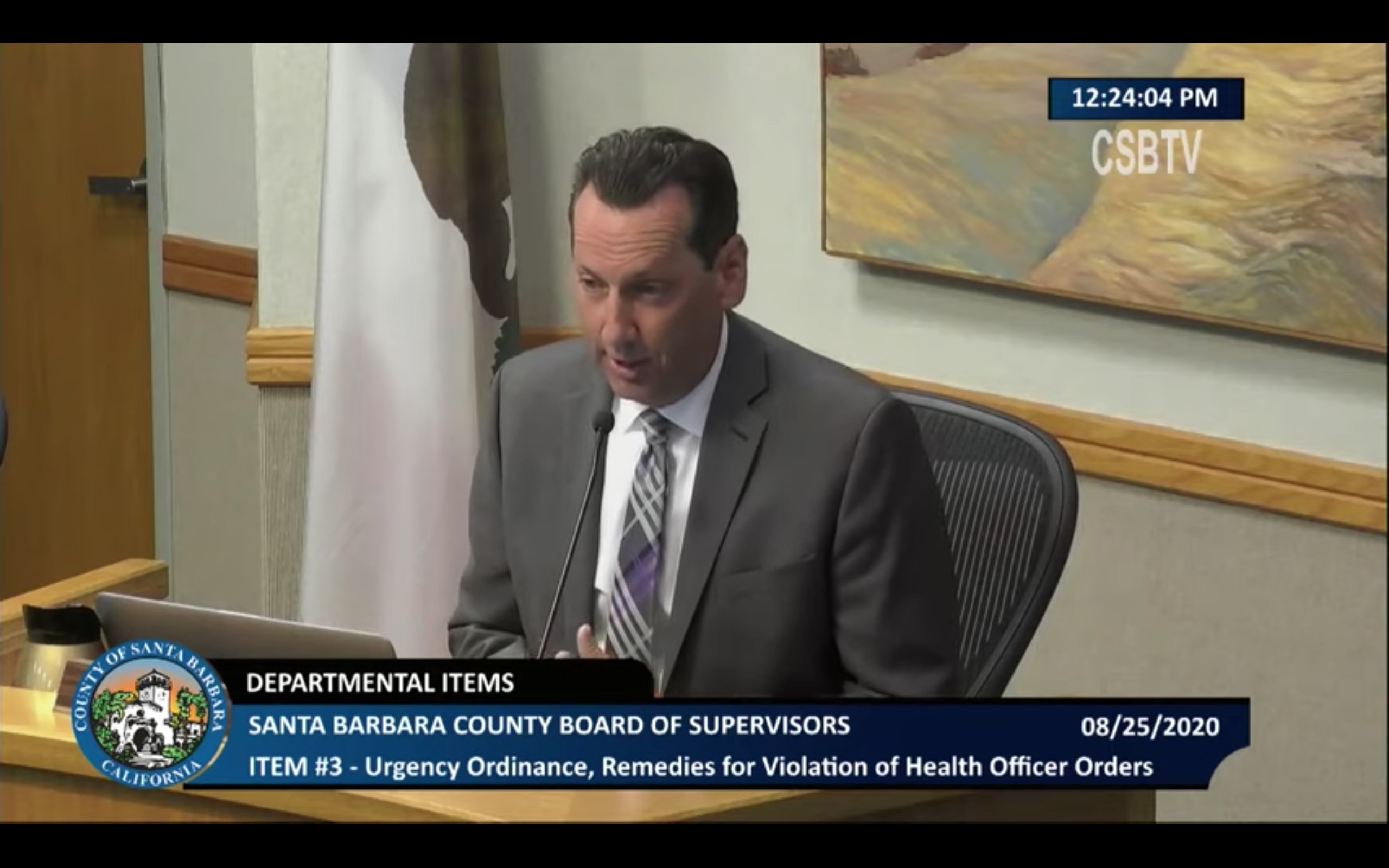Santa Barbara Supes Fail to Pass Strict Mask Ordinance
Coronavirus Cases Rise in Isla Vista but Fall in Rest of County

Santa Barbara County supervisors failed to pass a proposed urgency ordinance that would have fined anyone refusing to comply with county health officer orders just when active COVID-19 cases and hospitalizations across the county have started declining in recent weeks.
“I wear a mask anytime I’m out,” said 5th District Supervisor Steve Lavagnino, who voted against the ordinance. “If I go into a store, go just about anywhere around, I wear it. But at the same time I just think that this is a significant overreach.”
The timing made it difficult for him to justify the ordinance because data shows the disease situation is finally getting better. Active cases in Santa Maria, once the county’s largest COVID-19 hotspot, Lavagnino said, are now declining, which proves education and outreach works without giving out citations.
The urgency ordinance, which only got three votes instead of the required four, would have allowed for fines of up to $100 on the first violation, $200 on the second violation within one year, and $300 for the third violation within a year. Barney Melekian, assistant county executive officer, stressed that enforcement by citations would only be used in the most egregious cases and that education would always be the first foray.
About a dozen public commenters vehemently opposed the ordinance. Some cited studies that claim wearing masks is futile, while others brought up the mental-health and increased suicide rates as side effects of COVID-related ordinances. Many said the enforcement is unconstitutional, advising listeners in the public not to worry about fines if the ordinance passes because it’s unlawful.
“I feel like many of the mask dissenters that spoke brought up some important points, but I feel like they reached the wrong conclusion,” said 1st District Supervisor Das Williams. “To me, this mask-wearing is about control — returning to local control. It’s about that we are all concerned about the health effects and economic and psychological effects the other speakers talked about … The only way we can help society return back to normal is to reduce transmission rate, and there is decent scientific evidence that mask wearing in addition to other measures can help us return to that.
“My grandmother lived in occupied Europe,” he continued. “Mask wearing to me does not fit the description of draconian or Orwellian or allude to Robespierre’s Reign of Terror. I don’t think that they are comparable as someone who’s had a family member live in such regimes. I feel like it is a small price to pay for returning to a free society.”
Ultimately, Lavagnino and 4th District Supervisor Peter Adam voted against the urgency ordinance because they felt it constituted government overreach. Williams proposed that the supervisors revisit enforcement as a regular ordinance rather than an urgency one, even though it would take weeks longer to go into effect and require more detailed changes.
The supervisors voted 3-2 to bring it back as a regular ordinance at a later date; Adam and Lavagnino dissented.
Third District Supervisor Joan Hartmann was most concerned about Isla Vista. Although active cases and hospitalizations have declined across the county, Isla Vista has seen a more than 225 percent increase in positive cases in the past few weeks after college students have moved back.
Recent videos circulating on social media have shown young people at parties in Isla Vista without wearing masks or practicing social distancing. The chancellor of UCSB, Henry Yang, is encouraging students who can move home or obtain housing elsewhere to do so. The Public Health Department has also launched a social media campaign to encourage those in the college community to follow health orders.
“There is a lot of concern about law enforcement and resistance to armed officers coming and responding,” Hartmann said. “There’s a huge desire to see other kinds of professionals come out and respond to calls, whether it’s drug and alcohol or gatherings. I’d rather, if at all possible, not have armed responses to gatherings.”
COVID Data Update
Public Health Director Van Do-Reynoso also gave an update on the county’s COVID-19 data. There are 7,800 cases total since the initial outbreak of the virus, but the number of active cases over the past two weeks has decreased by 24 percent. New active cases are continuing to decline in Santa Maria, Lompoc, and Santa Barbara. In Goleta and particularly Isla Vista, active cases are increasing.
Do-Reynoso said hospitalization rates have decreased by 36 percent in the past two weeks and intensive care unit rates have continued to decrease by 39 percent.
The county is meeting the state’s metric requirements except for one. It requires fewer than 100 positive cases per 100,000 tests, and the county is still over the mark at 138 positive cases per 100,000.
Correction: An earlier version of this story incorrectly stated that a state metric required Santa Barbara County to have fewer than 25 positive cases per 100,000 tests. In fact, the county must maintain less than 100 cases per 100,000.


